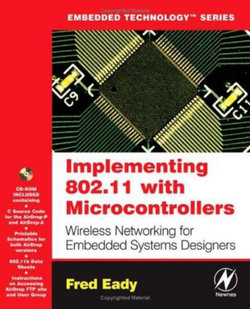What s on the CD-ROM?
Ch apter 1: Why Are We Doing This?
Selecting a Suitable Micro controller
Selecting a Suitable 802.11b Communications Dev ice
802.11b Hardware Overview
AirDrop Basics
Chapter 2: The AirDrop-P
The A irDrop-P Hardware
Learn to Play Guitar and Become Famous
Chapter 3: The AirDrop-A
The Air Drop-A Hardware
Bowing Out
Chap ter 4: 802.11b CompactFlash Network Interface Cards
They W ere Not Designed To Do This
The TEW-222CF
Ne ver Ignore an Inquisitive Author with Hand Tools
Unwrappin g the TEW-222CF
An Undercover Look at the Zonet ZCF1100
What s Behind Door Number 4
RF, Witchcraft, Po inty Hats, Ghouls, Goblins Same Thing
Chapter 5: Talking with 802.11bCompactFlash NICs
Physically Conne cting a Microcontroller to a CompactFlash Card
Musical Ove perspective against the other wireless standard options. Just enough theory and mathematics is provided to give the depth of understanding needed for practical design work. The book thoroughly covers: DPAC Module introduction and theory Laptop wireless Ethernet card introduction and theory Implementing the DPAC module in an embedded environment Introduction to PCMCIA-to-microcontroller interfacing Implementing the laptop wireless Ethernet card in an embedded environment In addition, the book includes a CDROM containing all of the code, schematics and programs necessary to implement embedded 802.11 wireless networking. Wireless design using microcontrollers requires specialized knowledge that many embedded designers don t have. Although a lot of information does exist on creating the sort of wireless embedded devices covered in this book, it takes a tremendous amount of time to pull it together from various manufacturer s websites, databooks, and complex standards documents. This book assembles the needed information to design an embedded device incorporating 802.11 wireless networking capability and provides step by step detailed design examples, for proven working designs based on familiar microcontrollers (instead of much more expensive and complex predesigned boards that are commonly used using a $5 microcontroller vs. a $200 board means a lot to a product s bottom line!).




Share This Book: